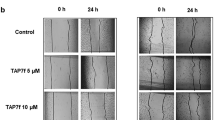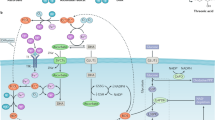Abstract
Background
Relapse of melanoma after surgical treatment remains a significant clinical problem in need of novel therapies. Vitamin E succinate (VES) is a promising antitumor micronutrient. We evaluated the effect of VES on melanoma dormancy and angiogenesis.
Methods
B16F10 melanoma cells were allografted in mice. The effect of VES on melanoma dormancy was measured by monitoring tumor volume. Tumor vascularity was quantitated with CD31 immunostaining. The expression of vascular endothelial growth factor (VEGF), VEGF receptor 1, and VEGF receptor 2 in tumors was assessed by the intensity of immunostaining. VES effect on secreted VEGF protein and VEGF promoter activity was measured with enzyme-linked immunosorbent assay and transient transfection assay, respectively. Significance was determined by analysis of variance.
Results
VES promoted melanoma dormancy (P=.0019) and inhibited melanoma angiogenesis (P<.0001). VES also significantly suppressed the expression of VEGF, VEGF receptor 1, and VEGF receptor 2 in melanoma tumors (P<.0001). Melanoma VEGF secretion (P=.0077) and melanoma VEGF promoter activity (P<.05) were significantly inhibited by VES.
Conclusion
VES promotes melanoma dormancy and inhibits melanoma angiogenesis. The mechanism of the VES antiangiogenesis effect involves the inhibition of VEGF gene transcription. These findings support future studies of VES in the prevention of melanoma metastasis.
Similar content being viewed by others
References
Greenlee R, Muray T, Bolden S, Wingo P. Cancer statistics 2000.CA Cancer J Clin 2000;50:7–33.
Balch CM, Buzaid AC, Soong SJ, et al. Prognostic factors analysis of 17.600 melanoma patients: validation of the American Joint Committee on Cancer melanoma staging system.J Clin Oncol 2001;19:3622–34.
Balch CM. Cutaneous melanoma: prognosis and treatment results worldwide.Semin Surg Oncol 1992;8:400–14.
Lotze MT. Cutaneous melanoma. In: Vincent T, DeVita J, eds.Cancer: Principles and Practice of Oncology. 6th ed. Philadelphi: Lippincott Williams & Wilkins, 2001:2012–70.
Kirkwood JM. Ajuvant interferon in the treatment of melanoma.Br J Cancer 2000;82:1755–6.
Kirkwood JM, Ibrahim JG, Sosman JA, et al. High-dose interferon compared with the GM2-KLH/QS-21 vaccine in patients with resected stage IIB-III melanoma: results of intergroup trial E1694/S9512/C509801.J Clin Oncol 2001;19:2370–80.
Fidler IJ. Seed and soil revisited: contribution of the organ microenvironment to cancer metastasis.Surg Oncol Clin North Am 2001;10:257–69, vii–viii.
Barnhill RL, Piepkorn MW, Cochran WR, Flynn E, Karaoli T, Folkman J. Tumor vascularity, proliferation, and apoptosis in human melanoma micrometastases and macrometastases.Arch Dermatol 1998;134:991–4.
Barnhill RI. The biology of melanoma micrometastases.Recent Results Cancer Res 2001;158:3–13.
Barnhill RL, Fandrey K, Levy MA, Mihm MC Jr, Hyman B. Angiogenesis and tumor progression of melanoma. Quantification of vascularity in melanocytic nevi and cutaneous malignant melanoma.Lab Invest 1992;67:331–7.
Denijn M, Ruiter DJ. The possible role of angiogenesis in the metastatic potential of human melanoma. Clinicopathological aspects.Melanoma Res 1993;3:5–14.
Neitzel LT, Neitzel CD, Magee KL, Malafa MP. Angiogenesis correlates with metastasis in melanoma.Ann Surg Oncol 1999;6: 70–4.
Ribati D, Vacca A, Palma W, Lospalluti M, Dammacco F. Angiogonesis during tumor progression in human malignant melanoma.EXS 1992;61:415–20.
Folkman J. What is the role of angiogenesis in metastasis from cutaneous melanoma?Eur J Cancer Clin Oncol 1987;23:361–3.
Folkman J. Tumor angiogenesis: therapeutic implications.N Engl J Med 1971;285:1182–6.
Folkman J. What is the evidence that tumors are angiogenesis dependent?J Natl Cancer Inst 1990;82:4–6.
Folkman J. The role of angiogenesis in tumor growth.Semin Cancer Biol 1992;3:65–71.
Folkman J. Angiogenesis-dependent diseases.Semin Oncol 2001; 28;536–42.
Hanahan D, Folkman J. Patterns and emerging mechanisms of the angiogenic switch during tumorigenesis.Cell 1996;86:353–64.
Ferrara N, Davis-Smith T. The biology of vascular endothelial growth factor.Endocr Rev 1997;18:4–25.
Mowlavi A, Malafa MP. Angiogenesis in primary tumor cells of metastatic and nonmetastatic malignant melanoma.Plast Reconstr Surg 2000;106:514.
Vlaykova T, Laurila P, Muhonen T, et al. Prognostic value of tumour vascularity in metastatic melanoma and association of blood vessel density with vascular endothelial growth factor expression.Melanoma Res 1999;9:59–68.
Ugurel S, Rappl G, Tilgen W, Reinhold U. Increased serum concentration of angiogenic factors in malignant melanoma patients correlates with tumor progression and survival.J Clin Oncol 2001;19:577–83.
Salven P, Heikkila P, Joensuu H. Enhanced expression of vascular endothelial growth factor in metastatic melanoma.Br J Cancer 1997;76:930–4.
Mardoval J, Moreno A, Graells J, et al. Angiogenesis and malignant melanoma. Angiogenesis is related to the development of vertical (tumorigenic) growth phase.J Cutan Pathol 1997;24: 212–8.
Erhard H, Rietveld FJ, van Altena MC, Brocker EB, Ruiter DJ, de Waal RM. Transition of horizontal to vertical growth phase melanoma is accompanied by induction of vascular endothelial growth factor expression and angiogenesis.Melanoma Res 1997;7(Suppl 2):S19–26.
Claffey KP, Brown LF, del Aguila LF, et al. Expression of vascular permeability factor/vascular endothelial growth factor by melanoma cells increases tumor growth, angiogenesis, and experimental metastasis.Cancer Res 1996;56:172–81.
Oku T, Tjuvajev JG, Miyagawa T, et al. Tumor growth modulation by sense and antisense vascular endothelial growth factor gene expression: effects on angiogenesis, vascular permeability, blood volume, blood flow, fluorodeoxyglucose uptake, and proliferation of human melanoma intracerebral xenografts.Cancer Res 1998; 58:4185–92.
Rak J, Yu JL, Klement G, Kerbel RS. Oncogenes and angiogenesis: signaling three-dimensional tumor growth.J Investig Dermatol Symp Proc 2000;5:24–33.
Sidky YA, Borden EC. Inhibition of angiogenesis by interferons: effects on tumor- and lymphocyte-induced vascular responses.Cancer Res 1987;47:5155–61.
Prasad KN, Edwards-Prasad J. Vitamin E and cancer prevention: recent advances and future potentials.J Am Coll Nutr 1992;11: 487–500.
Malafa MP, Neitzel LT. Vitamin E succinate promotes breast cancer tumor dormancy.J Surg Res 2000;93:163–70.
Malafa MP, Fokum FD, Mowlavi A, Abusief M, King M. Vitamin E inhibits melanoma growth in mice.Surgery 2002;131:85–91.
Shklar G, Schwartz JL. Vitamin E inhibits experimental carcinogenesis and tumour angiogenesis.Eur J Cancer B Oral Oncol 1996;32B:114–9.
Barnett KT, Fokum FD, Malafa MP. Vitamin E succinate inhibits colon cancer liver metastases.J Surg Res 2002;106:292.
de Vries C, Escobedo JA, Ueno H, Houck K, Ferrara N, Williams LT. The fms-like tyrosine kinase, a receptor for vascular endothelial growth factor.Science 1992;255:989–91.
Shibuya M, Yamaguchi S, Yamane A, et al. Nucleotide sequence and expression of a novel human receptor-type tyrosine gene (flt) closely related to the fms family.Oncogene 1990;5:519–24.
Terman BI, Dougher-Vermazen M, Carrion ME, et al. Identification of the KDR tyrosine kinase as a receptor for vascular endothelial cell growth factor.Biochem Biophys Res Commun 1992; 187:1579–86.
Joukov V, Pajusola K, Kaipainen A, et al. A novel vascular endothelial growth factor, VEGF-C, is a ligand for the Flt4 (VEGFR-3) and KDR (VEGFR-2) receptor tyrosine kinases.EMBO J 1996;15:290–8.
Waltenberger JH, Claesson-Welsh L, Siegbahn A, Shibuya M, Heldin C. Differential signal transduction properties of KDR and Flt1, two receptors for vascular endothelial growth factor.Biol Chem 1994;269:26988–95.
Yoshida A, Anand-Apte B, Zetter BR. Differential endothelial migration and proliferation to basic fibroblast growth factor and vascular endothelial growth factor.Growth Factors 1996;13:57–64.
Veikkola T, Alitalo K. VEGFs, receptors and angiogenesis.Semin Cancer Biol 1999;9:211–20.
Shi Q, Le X, Abbruzzese JL, et al. Constitutive Sp1 activity is essential for differential constitutive expression of vascular endothelial growth factor in human pancreatic adenocarcinoma.Cancer Res 2001;61:4143–54.
Barnhill RL, Piepkorn MW, Cochran AJ, Flyn E, Karaoli T, Folkman J. Tumor vascularity, proliferation, and apoptosis in human melanoma micrometastases and macrometastases.Arch Dermatol 1998;134:991–4.
Sokol RJ, Butler-Simon N, Conner C, et al. Multicenter trial of d-alpha-tocoepheryl polythylene glycol 1000 succinate for treatment of vitamin E deficiency in children with chronic cholestasis.Gastroenterology 1993;104:1727–35.
Rak J, Kerbel RS. Ras regulation of vascular endothelial growth factor and angiogenesis.Methods Enzymol 2001;333:267–83.
Author information
Authors and Affiliations
Corresponding author
Rights and permissions
About this article
Cite this article
Malafa, M.P., Fokum, F.D., Smith, L. et al. Inhibition of angiogenesis and promotion of melanoma dormancy by vitamin E succinate. Annals of Surgical Oncology 9, 1023–1032 (2002). https://doi.org/10.1007/BF02574523
Received:
Accepted:
Issue Date:
DOI: https://doi.org/10.1007/BF02574523




